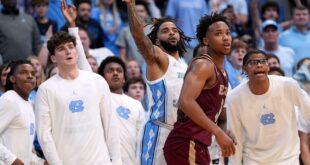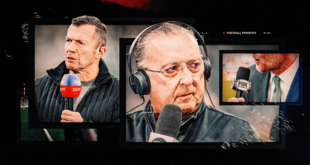Sunday night’s dramatic derby with city rivals Real Madrid put Atletico Madrid’s relationship with the radical block of fans that gather inside their ground under a new global spotlight.
After Real Madrid took the lead, Atletico captain Koke and manager Diego Simeone pleaded for calm with balaclava-wearing supporters, who had thrown objects onto the pitch at rival goalkeeper Thibaut Courtois for his supposedly provocative celebrations.
The match was suspended for 20 minutes before Angel Correa’s 95th-minute equaliser gave Simeone’s side a 1-1 draw.
After the final whistle, Atletico’s players celebrated in front of the section where the small number of supporters involved in the object-throwing regularly congregate — behind the goal at the south end of their Estadio Metropolitano, which on Sunday welcomed a record crowd of 70,112.
The whole night shone a spotlight on the more radical elements of Atletico’s support, especially the Frente Atletico ‘ultras’ (fans marked out for their choreographed and fanatical support) and their long and complicated relationship with the club’s hierarchy and the current team.
It also drew further attention to the stormy relationship between the Spanish capital’s two biggest football clubs, including historical grievances on the Atletico side, and the racist abuse Real Madrid’s Vinicius Junior has suffered around recent meetings between the sides.
Here, The Athletic dives into the deeper questions behind what happened.
Who are the Frente Atletico?
The Frente Atletico was formed in 1982, originally influenced by ultras movements in Italy and the UK. Atletico recognised it as an official supporters club and encouraged them as they brought atmosphere with chants and banners, motivated players and attracted bigger crowds to the stadium. Frente leaders got to know then-Atletico president Jesus Gil, occasionally socialising with Atletico players and appearing on Spanish radio shows in the 1980s.
Over time, Frente members holding more radical right-wing views took control of the group. They were also attracted by money-making opportunities, as Atletico facilitated the sale of blocks of match tickets that the Frente leadership could control. This continued after Atletico were converted into a private company in 1992, with Gil and film producer Enrique Cerezo taking control in a move Spain’s supreme court later deemed illegal — but no action followed as the court also said that the statute of limitations had passed.

Atletico’s Metropolitano had a record crowd on Sunday night (Florencia Tan Jun/Getty Images)
There was often violence involved with the Frente. In the 1980s, some members would ‘defend’ Atletico fans from opposition ultras at away games. There were also clashes with police.
The group became increasingly radical. Frente members attacked and killed Real Sociedad supporter Aitor Zabaleta near Atletico’s old Vicente Calderon stadium in 1998. Despite this, Frente retained its privileges with the club, continuing to sell match tickets and storing its banners and drums at the Calderon.
More recently, in November 2014, Deportivo La Coruna ultra Javier ‘Jimmy’ Romero Taboada was killed during an organised fight between Depor and Atletico fans before a game at the Calderon.
How could such a group still be allowed into Atletico’s stadium?
After Romero Taboada’s death, Atletico revoked the Frente’s official status and banned some members from the Calderon. Over the next few years, Atletico began to modernise on and off the pitch, most notably moving to the Estadio Metropolitano on Madrid’s outskirts. Twelve consecutive seasons of Champions League football under Simeone have brought extra revenue and status as one of Europe’s elite clubs.
But Frente-aligned clothes, banners and chants are still a part of the Metropolitano’s matchday experience. Incidents are less frequent but still serious, including an Atletico ultra displaying a Nazi swastika at a game in May 2018 and a far-right banner flown in their section of the stadium during that year’s Europa League final against Marseille in Lyon.

The scene inside Atletico’s ground before kick-off on Sunday night (Gonzalo Arroyo Moreno/Getty Images)
There have also been battles for control of Atletico’s most radical fans and the moneymaking opportunities presented by the Frente ‘brand’, such as ‘official’ scarves and T-shirts. A man was hospitalised in January 2018 after a fight between members of different hardcore Atletico groups outside the Metropolitano. A new radical group, ‘Suburbios Firm’, has emerged — its members are already banned from attending home games, but sometimes support the team away.
In practical terms, especially within the stadium, the ‘Frente’ is now more of an idea than an actual group of paid-up members. Ultras from the 1990s and 2000s are older and less likely to attend matches. The club recognise an ‘animation section’ of fans behind the goal but they have long ended the practice of facilitating blocks of tickets for sale by ultras leaders.
Atletico say they can only ban individuals from the stadium after they have committed a crime and that it is impossible (and illegal) to take collective action against groups of people without evidence of wrongdoing. “We cannot expel 200 people from the stadium because someone believes they belong to a certain group or because they wear a certain T-shirt,” a club spokesperson told The Athletic. “The image might be awful, but there has to be a crime committed for action to be taken.”
After Sunday’s events, an Atletico statement said the club was committed to “working with the police to locate those involved, one of whom has already been identified”.
Were they involved in the racist abuse of Vinicius Jr?
Last December, four members of Frente Atletico were charged over the hanging of an effigy dressed to resemble Vinicius Jr from a bridge near Real Madrid’s training ground in January 2023. The mannequin was hung next to a 16-metre banner that read “Madrid hates Real” and was displayed hours before a Madrid derby in the Copa del Rey quarter-finals.

GO DEEPER
Four ultras charged over Vinicius Jr effigy
After last season’s Metropolitano ‘derbi’, police identified individuals who were caught on camera racially abusing the Brazilian. Atletico revoked their status as club members, banning them from the stadium. Similarly, when one ‘fan’ racially abused Athletic Bilbao’s Nico Williams in April, he was also expelled and banned.
Before Sunday’s game, messages on social media circulated with some apparent Atletico fans urging supporters to wear masks to the game to avoid detection by cameras when making racist insults, specifically calling Vinicius Jr a monkey.

Real Madrid goalkeeper Thibaut Courtois throws a lighter off the pitch (Florencia Tan Jun/Getty Images)
No racist abuse of Vinicus Jr was reported on Sunday, although there were chants against him when Madrid’s team bus arrived and whistles for his every intervention on the pitch.
Instead, the focus switched to Courtois, a former Atletico player who moved from Chelsea to Real Madrid in 2018.
How does Atletico’s self-image fit with all this?
Atletico fans, players and club officials have historically identified themselves as scrappy underdogs who fight against authority and power — especially against their richer and more glamorous city rivals. That self-image is deeply rooted within the club and most Atletico fans are convinced the media and authorities support Real Madrid.
Atletico went 14 years without a win against Real Madrid (1999-2013) and still feel that any victory for Atletico over Madrid is a victory for the little guy.
“These are difficult times and people identify with us as we are fighting against many adversities,” said then-Atletico midfielder Tiago in 2014 as Simeone’s side won that season’s league title — their third in 37 years. “We’re like Robin Hood.”
Simeone’s style of football — with its emphasis on hard work and physicality — fits Atletico’s traditions and the emotional connection with the stadium has played a key role. After each game, Atletico’s players salute all four corners of the stadium, starting with their more hardcore fans.
On Sunday, when the game was stopped after objects were thrown at Courtois, Atletico captain Koke and long-serving defender Jose Maria Gimenez ran behind the goal to speak with the fans in the area the objects had come from. Simeone also approached them, making a ‘calm down’ gesture.
After the game, as usual, Atletico’s players gathered on the edge of the penalty area to applaud the Fondo Sur (the hardcore group of fans who congregate behind the goal at the stadium’s south end), which many felt could be seen as a gesture of support for their behaviour during the game.

Simeone in front of the Fondo Sur section at Atletico’s ground on Sunday (Gonzalo Arroyo Moreno/Getty Images)
What do most Atletico fans think?
As the Frente is not an official group, nobody knows exactly how many members it has or how many regularly attend games. Some ultras who lead chants behind the goal have often covered their faces with scarves or balaclavas to avoid identification.
The vast majority of Atletico fans do not like the Frente at all. Many keep away from the bars where the hardcore ultras drink before games and also steer clear of them in the stadium.
Divides within the fanbase are clear. In November 2022, the Fondo Sur left their area empty for the first half of a game against Espanyol, protesting the team’s poor displays. Fans in other areas of the stadium loudly whistled them when they did enter.
On Sunday evening, when the referee took the players off the pitch in the second half, this divide was again evident. Amid a surreal silence in most of the ground, ultras behind the goal continued to chant and jump and down, only to be met by whistles from other areas of the ground. There were also whistles when the team went to applaud the Fondo Sur on the final whistle.

Atletico players acknowledging fans after the final whistle on Sunday (Gonzalo Arroyo Moreno/Getty Images)
“I was there and I was one of those who whistled the Frente,” said one Atletico fan (as the supporters consulted for this article work in football, they spoke anonymously to protect their position). “Atletico fans are fed up and embarrassed by what happened.”
Another supporter said: “Ninety-nine per cent of the people in that stand are normal, but those who dominate are the brainless ones.”
Atletico’s ‘embattled underdog’ identity can blend into a feeling of persecution among regular fans, not just Atletico’s more radical ultras. Many agreed when Simeone said after Sunday’s game that Courtois bears responsibility for the way he celebrated Madrid’s opening goal. TV pictures showed him mouthing, ‘Vamos’ (come on) as he moved his hand towards the stands — a proactive gesture, in the view of home fans. Moments before the goal, chants of, “Courtois die” had been heard.
Courtois is not popular among Atletico fans. Since joining Real Madrid, they feel he has been disrespectful towards his former team, who he represented from 2011 to 2014. Like all players who have made more than 100 Atletico appearances, he has a plaque on the ‘centenary players’ walk’ on the stadium concourse. As they always do whenever Courtois plays at the Metropolitano with Real, Atletico fans left rubbish and other debris on his plaque.
What does the rest of Spanish football make of Atletico’s hardcore fans?
After Romero Taboada’s death in 2014, there was a concerted effort from Spanish football authorities to weaken ultras’ influence, even trying to keep them out of stadiums.
Many other clubs — including Real Madrid and Barcelona — have banned individuals and groups. They have also introduced their own ‘official’ animation sections, which are more tightly controlled by club authorities, so behaviour can be more easily policed.

GO DEEPER
Real Madrid’s south stand: How the club transformed a former far-right stronghold
La Liga’s reputation took a battering following the global uproar at the racist abuse that Vinicius Jr suffered in Valencia’s Mestalla stadium last year and the league’s executives have since reacted much more seriously to any incidents of racism within or around Spanish stadiums, and also online.

Vinicius Jr has been racially abused by fans at several La Liga grounds (Aitor Alcalde/Getty Images)
La Liga’s official response on Sunday evening to the events inside the stadium was relatively restrained, with a post on X saying there was “zero tolerance for any acts of violence inside or outside our stadiums”.
Local coverage of the events, which made many headlines in international media, was also quite restrained. There were no angry op-eds calling for the Metropolitano to be closed or for the complete banning of all ultras from Spanish stadiums.
The Spanish Football Federation and La Liga have yet to decide what punishment Atletico will receive for Sunday’s incident. They could try to close parts of the stadium for a few games, but that may be difficult to impose. Real Betis successfully appealed such a sanction when a Sevilla player was hit by an object thrown from the stands in January 2022. Atletico also successfully appealed in April when a section of the stand was closed for two games after Williams was racially abused, arguing that it was unfair to punish a whole group for the behaviour of one individual.

GO DEEPER
The shocking abuse Real Madrid’s Vinicius Jr faced at Valencia revealed in new report
What about Atletico’s international image and the club’s medium-term future?
The evolution of Atletico into one of Europe’s elite clubs continued this summer, with the investment of more than €200million (£166.6m; $222.2m) in big international stars, including Julian Alvarez and Conor Gallagher.
It added to a feeling that Atletico’s hierarchy are looking to take a big leap forward. This summer, €70m was raised from the club’s shareholders, which include UK-Israeli company Quantum Pacific and U.S. investors Ares Management Corporation. Chief executive Miguel Angel Gil Marin laid the first stone at a new training ground on a site beside the Metropolitano.
Many within the Spanish football industry believe that Gil Marin and Cerezo will sell their controlling interest in Atletico to foreign investors. Sunday’s disgraceful scenes, which echoed around the world, will not have helped drum up interest.
When reporters asked Cerezo on Sunday afternoon about the online hate messages about Vinicius Jr, he first said, “At Atletico Madrid, I don’t consider that there is anyone anti-racist or racist.” Later, at the stadium, he clarified to broadcasters DAZN that he “meant to say that we all have a responsibility to fight against racism”.

Cerezo (centre) in conversation with Real Madrid counterpart Florentino Perez (Oscar J Barroso/Europa Press via Getty Images)
Atletico are keen to project a more modern positive image and have launched campaigns in the stadium and online to educate their fans.
“’We Love Football’ is a project to channel all of our actions aimed to build a sport where diversity, inclusion, respect and tolerance inspire society,” the club’s website says.
On Sunday, Atletico quickly released a statement saying the club was working with police to identify all individuals who threw objects onto the pitch and that they will be banned from attending games. Since Sunday, Atletico have also changed their statutes so that fans who wear masks to avoid identification can be immediately expelled from the stadium.
There is an awareness at Atletico — within the club and among the fans — that their image has been badly damaged. The vast majority of fans are adamant that the Frente does not represent their views and the club say they are doing all they can to stamp out their influence — but the connection is still strong between the team and the section of the stand where there is continuing anti-social (and worse) behaviour.
“The image of the players talking to fans wearing balaclavas, and then going to applaud the stand at the end of the game, was terrible,” said another Atletico fan. “The club still has a lot of work to do.”
(Top photo: Gonzalo Arroyo Moreno/Getty Images)
Source link
 meganwoolsey Home
meganwoolsey Home



